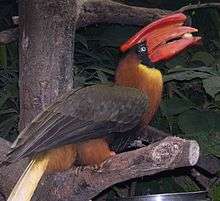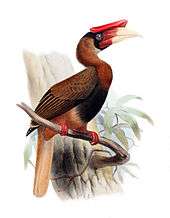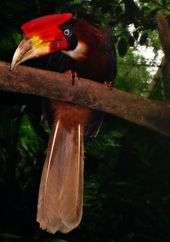Rufous hornbill
| Rufous hornbill | |
|---|---|
 | |
| Buceros h. hydrocorax | |
| Scientific classification | |
| Kingdom: | Animalia |
| Phylum: | Chordata |
| Class: | Aves |
| Order: | Bucerotiformes |
| Family: | Bucerotidae |
| Subfamily: | Bucerotinae |
| Genus: | Buceros |
| Species: | B. hydrocorax |
| Binomial name | |
| Buceros hydrocorax Linnaeus, 1766 | |
| Synonyms | |
| |
The rufous hornbill (Buceros hydrocorax), also known as the Philippine hornbill and locally as kalaw (pronounced kah-lau), is a large species of hornbill.
Distribution and habitat
It is endemic to the Philippines, where it occurs in primary, mature secondary and disturbed forests on 11 islands: Luzon and Marinduque (race hydrocorax), Samar, Leyte, Bohol, Panaon, Biliran, Calicoan and Buad (race semigaleatus), Dinagat, Siargao, Mindanao (plus Balut, Bucas and Talicud) and Basilan (race mindanensis). It is still common locally, notably in the Sierra Madre of Luzon, but continues to suffer from substantial hunting pressure and widespread loss of habitat.

Description

The bill of the nominate subspecies is entirely red, while the bill of the subspecies semigaleatus and mindanensis are pale yellow on the distal half.
Behaviour
It is sometimes called "the clock of the mountains" because of its periodic noontime call.[2]
Breeding
As with other hornbills, females seal themselves within the nest cavity, where they lay the clutch, and remain with the growing young for most or all of the nesting period. In some species, the male helps with the sealing process from outside the nest cavity. The nestlings and the female are fed by the male through a narrow vertical slit in the sealed nest opening.[3]
References
| Wikimedia Commons has media related to Buceros hydrocorax. |
- ↑ Buceros hydrocorax, IUCN Red List, 2014
- ↑ Ortiz, Margaux C. "Hornbills in the city: Clock ticking on nature’s timekeeper". Philippine Daily Inquirer.
- ↑ Witmer, Mark (1993). "Cooperative Breeding by Rufous Hornbills on Mindanao Island, Philippines" (PDF). The Auk. 110 (4): 933–936. doi:10.2307/4088652.
